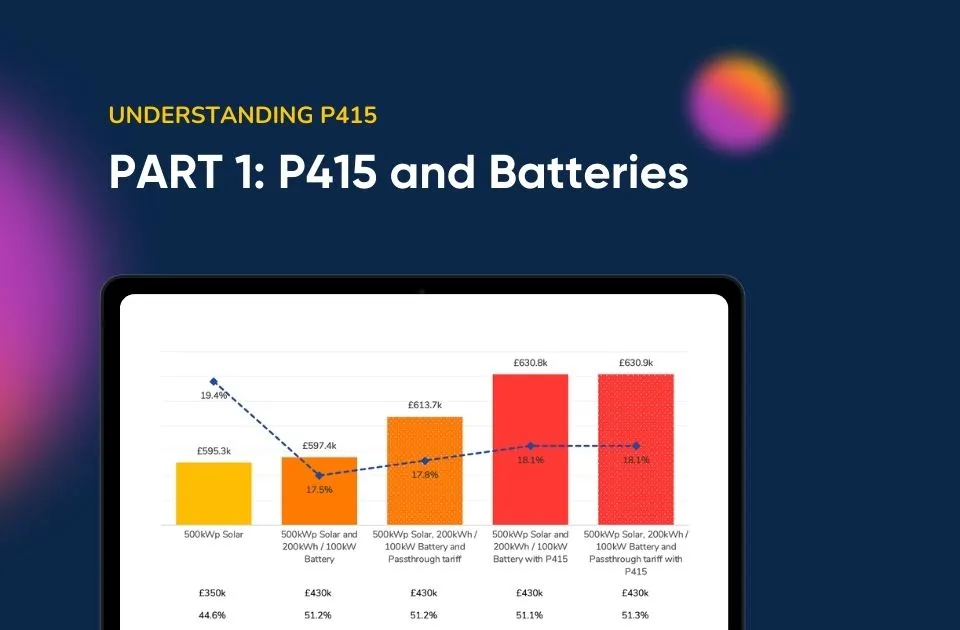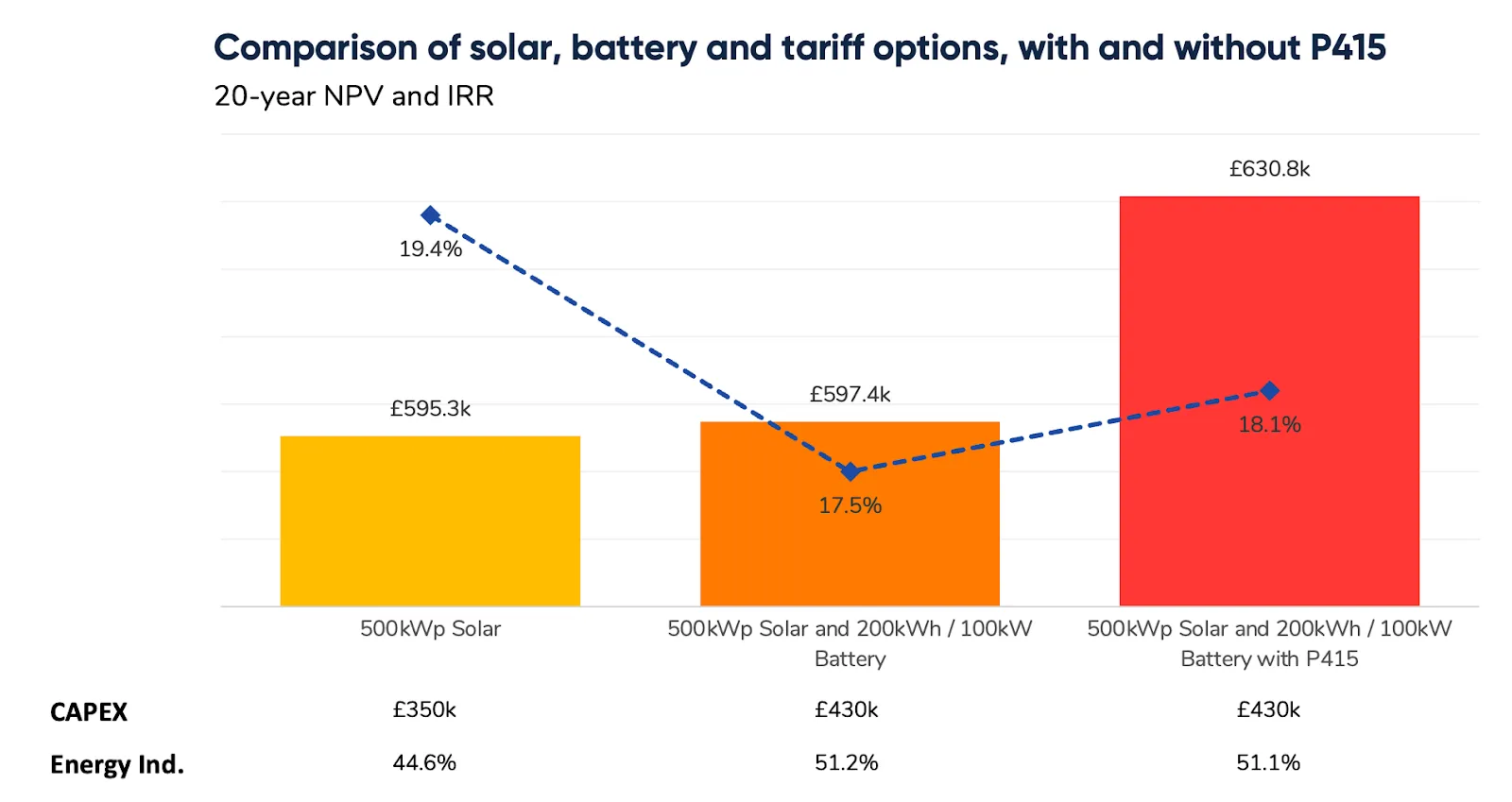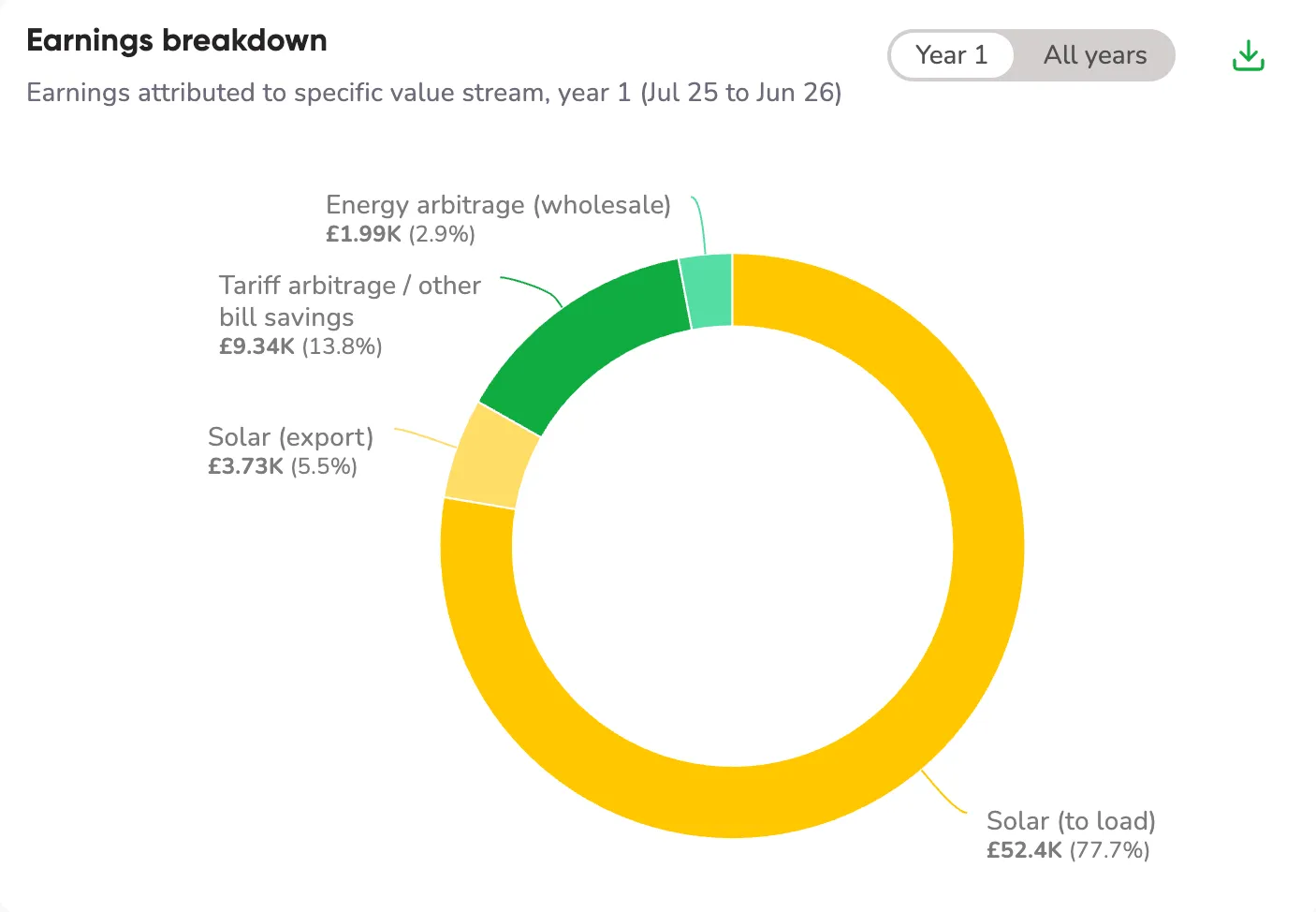Blog /
Industry Insights
P415 and Batteries: Part 1
August 14, 2025

What is P415, and How Does it Impact Commercial Battery Projects?
This blog is part of a multi-part series that unpacks in detail the P415 rule change in the UK, and how it is managed in Orkestra. Read Part 2 here.
Since its implementation in November 2024, the P415 energy market rule change in the UK has generated significant excitement among commercial battery proponents and aggregators. But does the hype around P415 stand up to scrutiny? Does P415 add instant value to every battery project?
In this article, we break down the P415 rule change: what it is, when it can be used, and how to assess whether it will boost revenue for your commercial projects.
What is P415?
P415 refers to a modification to the Balancing & Settlement Code (BSC) set by the National Energy System Operator (NESO) in the UK. The rule change provides a means by which a battery installed behind the meter can participate in wholesale electricity markets via an asset meter and without needing to upset existing electricity supplier contracts. It facilitates access to wholesale markets for flexible loads and batteries through a licensed aggregator known as a Virtual Trading Party.
For those selling and installing batteries, it's important to understand this potential revenue opportunity, as P415 creates a pathway to another layer of revenue for a behind-the-meter battery in the UK.
So in theory, a commercial battery gains a new avenue to participate in wholesale electricity markets, such as the day-ahead or intraday markets, and the owner receives more revenue from their battery.
Why Use P415
As renewable energy generation increasingly makes electricity markets more volatile, a key emerging value stream for commercial batteries is wholesale market arbitrage. This means charging a battery when market prices are low and discharging when market prices are high. When it comes to commercial solar projects in the UK this is critical, as it means adding a battery can deliver additional value for the owner all year round.
To access this value stream, batteries need access to the wholesale market through one of two approaches:
- Option A - Expose the whole site to wholesale markets: The entire site faces wholesale market prices, creating price risk for all electricity consumption. This model typically suits large businesses with specialist teams managing wholesale price exposure.
- Option B - Install an asset meter on the battery and expose only the battery to the wholesale market using P415: The P415 asset meter is used to expose only the battery's "flexibility" to the wholesale market. The site's main electricity supply contract continues largely unchanged, without direct supplier involvement in wholesale trading arrangements.

How Much Extra Value Does P415 Add?
Unfortunately, the answer is: it depends. Several factors determine P415's value:
- Load profile
- Onsite generation
- Connection constraints
- Site tariff structure
- Which markets will a battery participate in via P415
- And, CRITICALLY, the baselining methodology used in conjunction with P415. Why? The baselining methodology determines how much of a battery's capacity can be bid into the wholesale market. Via P415, a Virtual Trading Party (VTP) can only bid "deviation volumes" versus the baseline. (more on this in Part 2 of this blog)
We find the best way to explore this is using a simple case study example to start layering out these factors, as outlined below.
Case Study Analysis
To explore the value and impact of P415, we’ve set up a typical commercial solar and battery site in Orkestra: a logistics centre with a 100 kW, 2-hour battery with optimised control co-located with a 500 kW solar system, using a two-rate (day/night) tariff and with an export limit of 100kW.
In the chart below, we can compare three different potential solar and battery solutions for the site. Comparing the first scenario, solar only, to the second, we can quickly see that simply adding a battery to the project (without considering tariff changes), provides only a slight improvement in the 20-year pre-tax NPV (with a 5% discount rate). But if we include a battery AND consider P415 in scenario 3, there is a much larger improvement on the overall value of the project.

Looking at the earnings breakdown on the project for the P415 scenario, we can see exactly where it adds an extra 3% value to the whole project, and 21% additional value to the battery portion of the project.

So we can see that P415 offers some additional value - but it is pretty marginal as we’re only considering single market participation, and have not made any changes to the (relatively simple) tariff.
The Impact of Market Participation on P415 Value
As mentioned above, the value of P415 is also determined by the specific markets your battery will participate in.
Single market participation is a more straightforward solution, as you only participate in one market, for example the day-ahead market. The day-ahead market is also the most obvious market participation option, as it's comparatively simple compared to intraday and continuous markets.
Multi-market participation on the other hand (considering day-ahead, intraday, and continuous markets together) might increase value, but it would also add project and control complexity, likely increasing OPEX.
As you may be realising - it's a tricky balancing act that requires some experimentation with different combinations to assess the potential feasibility - quite literally, why Orkestra exists. Sign up for our newsletter to stay updated as we add new features to further support and streamline your analysis.
The Impact of Tariff Optimisation on P415 Value
Different tariff arrangements will also significantly impact P415's value. Let’s consider two different tariff arrangements at the site meter:
- A bundled tariff - provides baseline value for P415 participation
- A pass-through tariff - exposes the site to DUoS tariffs, creating more price signal for the battery to optimise the load shape

Now we can see that the pass-through tariff can increase the battery value for the project, but in an interesting turn of events, it will also reduce the marginal value of P415. Why? Because you can only participate with your deviation volume, not the full capacity of the battery. The battery is already optimising for existing tariff signals and its discharge coincides with wholesale market events, so it cannot claim additional value from those events.
The Key to P415 Value: Understanding Baselines and Deviation Volumes
Here's the fundamental concept that determines whether P415 will add meaningful value to your project: you can only trade what's different from what your battery would do anyway.
This "difference" is called deviation volumes, and it's calculated through a process called baselining. Think of it this way: if your battery was already going to discharge at 4pm to avoid peak charges, you can't also claim wholesale market revenue for that same discharge through P415.
Understanding baselines and deviation volumes, and how they're calculated, is a critical piece to understand if you plan to utilise P415 for your project, we highly recommend you read blog 2 to ensure you're across the technical details.
Key Takeaways
The key takeaway from our analysis is clear: P415 offers additional value, but it should be viewed as a supplementary revenue stream rather than a project-defining opportunity, and it is critical to assess P415 in conjunction with tariff optimisation, to see which will deliver the most value.
Success with P415 depends heavily on site-specific factors, particularly:
- Tariff structure (simple tariffs leave more room for P415 gains, but a time of use tariff may be better for your project overall than P415)
- Load profiles and their alignment with wholesale price patterns
- Solar generation timing and export constraints
- Market participation scope (single vs. multi-market approaches)
Most importantly, value is also determined by how much your battery's optimal behaviour changes when wholesale markets are available - the deviation volumes. Read part two of our blog series "P415 Technical Deep Dive: Baselining and Deviation Volumes - the devil in the detail" for more on this critical concept (a must read if you do plan on exploring P415 or utilising Orkestra to model P415 for your projects!).
As you can see from our analysis, Orkestra enabled us to set up all these different potential scenarios for the commercial site, and assess in tandem which combination of solar, battery, and market participation will deliver the most value. In fact, it’s something we were able to set up and analyse in under 10 minutes.
Have an upcoming C&I project you’d like to explore? Start your free trial of Orkestra today, supported by our expert team.
Get your 3 week free trial
Get started exploring energy project feasibility analysis and reporting. Sign up now - no credit card required.
Sign up today
